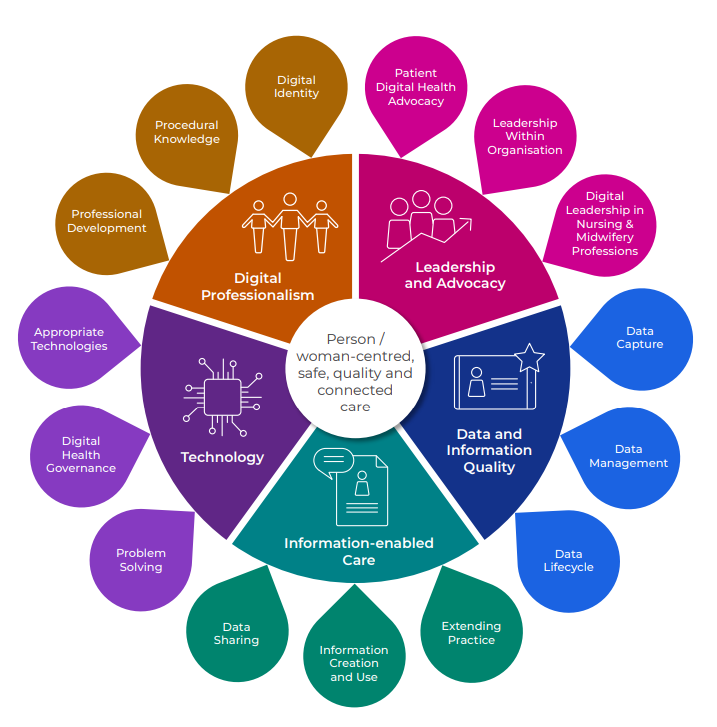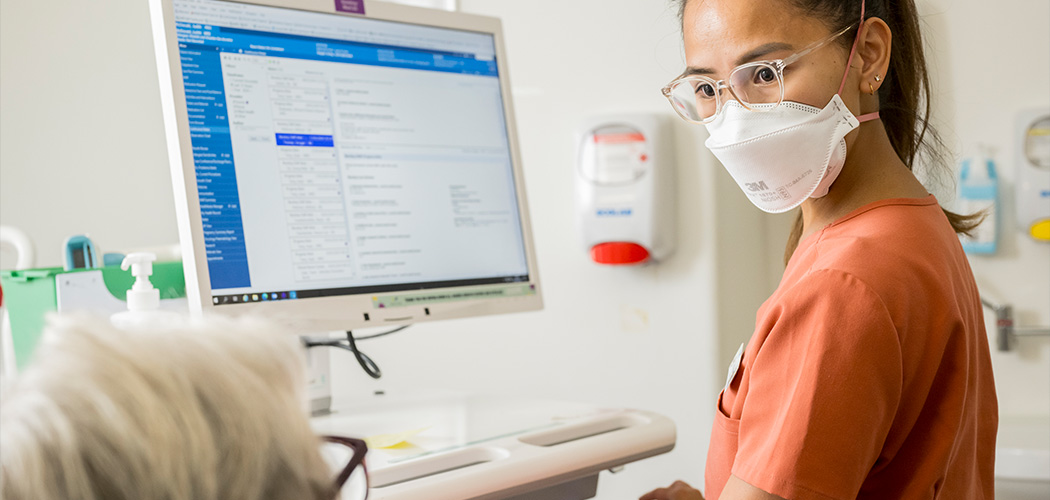Recommendation 68 of the Royal Commission into Aged Care Quality and Safety Report1 outlined implementation of digital technology and My Health Record into residential aged care facilities (RACFs).
Progress on implementation of Recommendations2 focus on My Health Record (MHR) and several funded projects to support registration of MHR and electronic medication charts.2 Further projects are planned to enable implementation of digital technology into RACFs, however, specific information is yet to be released. While progress has been made to support implementation of MHR at a systems level, this report highlights lack of funding to support the RACF workforce to become digitally capable as outlined by the National Nursing and Midwifery Digital Health Capability Framework (Figure 1)3 and enable leadership by nurses for successful implementation of digital technology into RACFs.
An Australian study about nurses’ perceptions about using mobile digital devices in an RACF provides direction about how to successfully implement digital technology into RACF staff workflows4. Findings suggest that any change management process involving nurses’ clinical practice should be considered to gain an understanding of both the benefits and risks of using digital technology such as mobile digital devices in RACFs. The introduction of digital technology requires an understanding of RACF clinical workflow, an adequate wireless (Wi-Fi) network system, along with the ability to incorporate nurses’ own perceptions and experiences to facilitate necessary changes to ensure safe and appropriate use of digital technology to provide quality healthcare4.
The study also emphasised the need for ongoing education and training to support all levels of learning for nurses that is inclusive and tailored to their specific requirements. Nurses identified many changes in working with a mobile digital device, including the negativity of increased alarms, which affected resident wellbeing. Nurses experienced unreliability of mobile digital devices due to constant Wi-Fi dropout. Unintended consequences were revealed as nurses developed workarounds to ensure effective communication. One safeguard was to carry another model telephone, hence two devices, to guarantee nurses would be able to call for assistance in case of emergency, due to the mistrust of Wi-Fi connection.

Systems failures, although external to the operations of the mobile digital device, impacted perceived usefulness and integrated use of mobile digital devices in delivery of healthcare. Weakness was not a result of the functionality of the mobile digital device but the network system and lack of education for end users. The prolonged failure of the Wi-Fi network, without a quick resolution caused much angst amongst nurses, resulting in a general belief amongst the RACF nursing team that the mobile digital device was faulty and inadequate.
Incorporating mobile digital device technology training at beginning of installation, prior to going live and provision of educational preparation to suit the nurses may have resolved many of the issues. Training tailored to the working environment encourages greater adoption of technology and smoother implementation5. Actively seeking feedback and adapting change to reflect safe and supportive care for nurses is essential for successful change management. The ability to learn from past failures and success, to help create a plan for future healthcare technology to advance nursing practice is invaluable for developing digital health technology capability of the aged care nursing profession6.
For Recommendation 681 to be successfully implemented requires nurses to lead change management within RACFs, ensure adequate systems infrastructure, organisational clinical governance, and timely individual professional development opportunities prior to implementation of digital technology into workplaces. The National Nursing and Midwifery Digital Health Capability Framework3 provides direction that will enable RACF nurses to model safe, effective, and appropriate healthcare to the next generation of health professionals. Nurses need to grasp this opportunity to lead the implementation of digital technology in RACFs for the benefit of residents. Advocating for enabling digital capability has the potential to transform nursing practice and contribute to delivery of contemporary 21st century healthcare in RACFs.
References
1 Royal Commissions. Royal Commission into Aged Care Quality and Safety, Final Report: Care, Dignity and Respect. Canberra, Australian Government 2021; March 1.
2 Australian Government Department of Health and Aged Care. Progress Report: Implementation of the Recommendations of the Royal Commission into Aged Care Quality and Safety. Canberra, Australian Government 2023; July.
3 Australian Digital Health Agency. National Nursing and Midwifery Digital Health Capability Framework. Sydney, NSW, Australian Government 2020.
4 Rennie, J. Nurses’ perceptions of using smartphone devices in residential aged care settings, University of Tasmania, (Unpublished thesis) 2024.
5 Chau S, Turner P. Examining the utilisation of mobile handheld devices at an Australian aged care facility. 2004; PACIS 2004 Proceedings; 50.
6 Siam J, Abdo A, Al Ju’beh M. Integration of smart mobile handset devices in a smart healthcare center organization: A proof of concept. In 2016 3rd MEC International Conference on Big Data and Smart City (ICBDSC), IEEE 2016 Mar 15: 1-5.
Authors:
Jennifer Rennie RN, Master of Education Student, School of Education, University of Tasmania
William Baker (SFHEA), Ed. D (RMIT), BA (Fine Art), M. Ed (Arts Admin), B. Mus. Ed (Melb), Grad Cert Ed (ULT), Senior Fellow (HEA), Senior Lecturer, Deputy Associate Head Learning & Teaching, Program Director Postgraduate Coursework, School of Education, University of Tasmania
Carey Mather, RN BSc GCert ULT GCert Creative Media Technology GCert Research, PGrad Dip Health Promotion MPH PhD MACN FAIDH FHEA, Senior Lecturer, School of Nursing, College of Health and Medicine, University of Tasmania, Launceston Tasmania Australia








